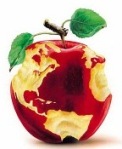As I live and travel through southeast Asia, I am reminded of how a geographer views the world - the earth is seen as a a globe and one can stand at different places around the globe to view it. We value the idea that we have a planet of varied cultures, peoples, and viewpoints. This strikes me forcefully when I watch television here in southeast Asia and as I read local newspapers - the world is seen here in significantly different ways from how it is seen in Framingham or Westfield, or Scituate. Following Middle East events on the BBC or Al Jazeera television compels one to consider that the perspectives presented on CNN or CBS are not the only ones that exist and that have validity. This is an important issue for geography teachers as we work to help our students better understand our planet, its people and places. We should not hesitate to seek alternative views on world events and present these to our students for this is where true learning can take place, as we analyze not one perspective, but differing viewpoints on the same event or place.
This issue was brought home to me very dramatically when I visited the "Museum of War Remnants" in Ho Chi Min City, Vietnam. The perspective on that war is very different from the one that Americans normally see and have accepted.

Here is a link to a site that has some photos of the museum exhibits.
And the impact of Agent Orange on present generations is something that people outside Vietnam give very little thought to. Here in Vietnam, it is a daily weight, impacting health in disfiguring ways.
A reminder that one of the tasks of the geography teacher is to look beyond the surface and explore how and why particular issues are viewed differently and seen as important in varied parts of our planet.
 Welcome to the Massachusetts Geography Alliance blog space.
Welcome to the Massachusetts Geography Alliance blog space.







